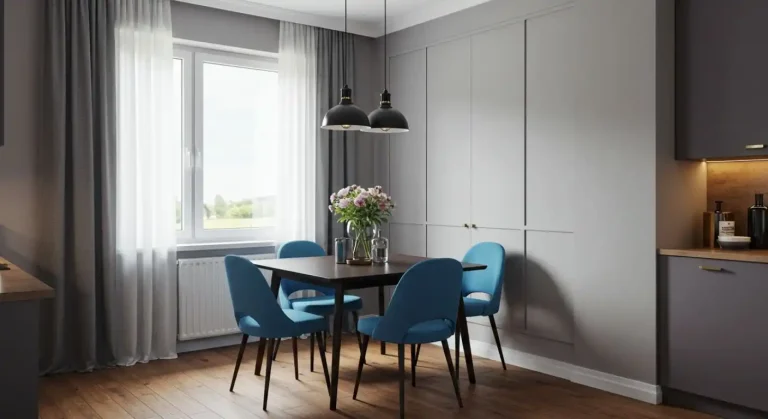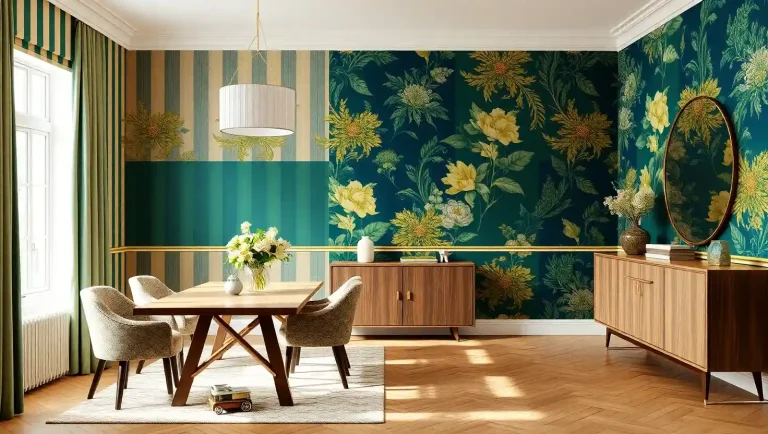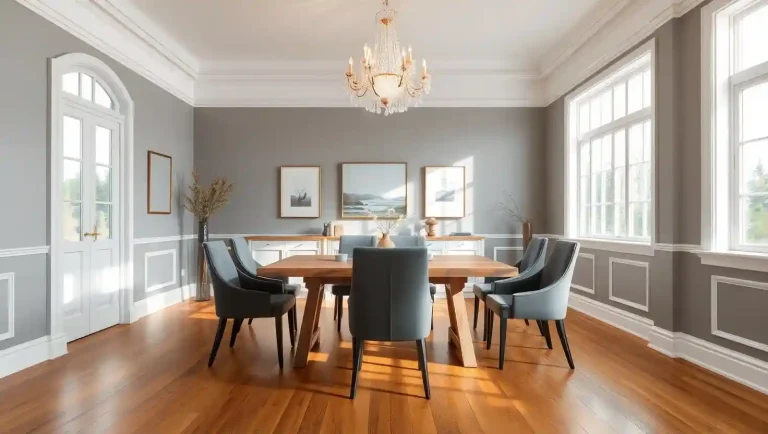What Colors Should a Farmhouse Dining Room Have
When it comes to designing a farmhouse dining room, color plays a pivotal role in setting the tone and atmosphere of the space.
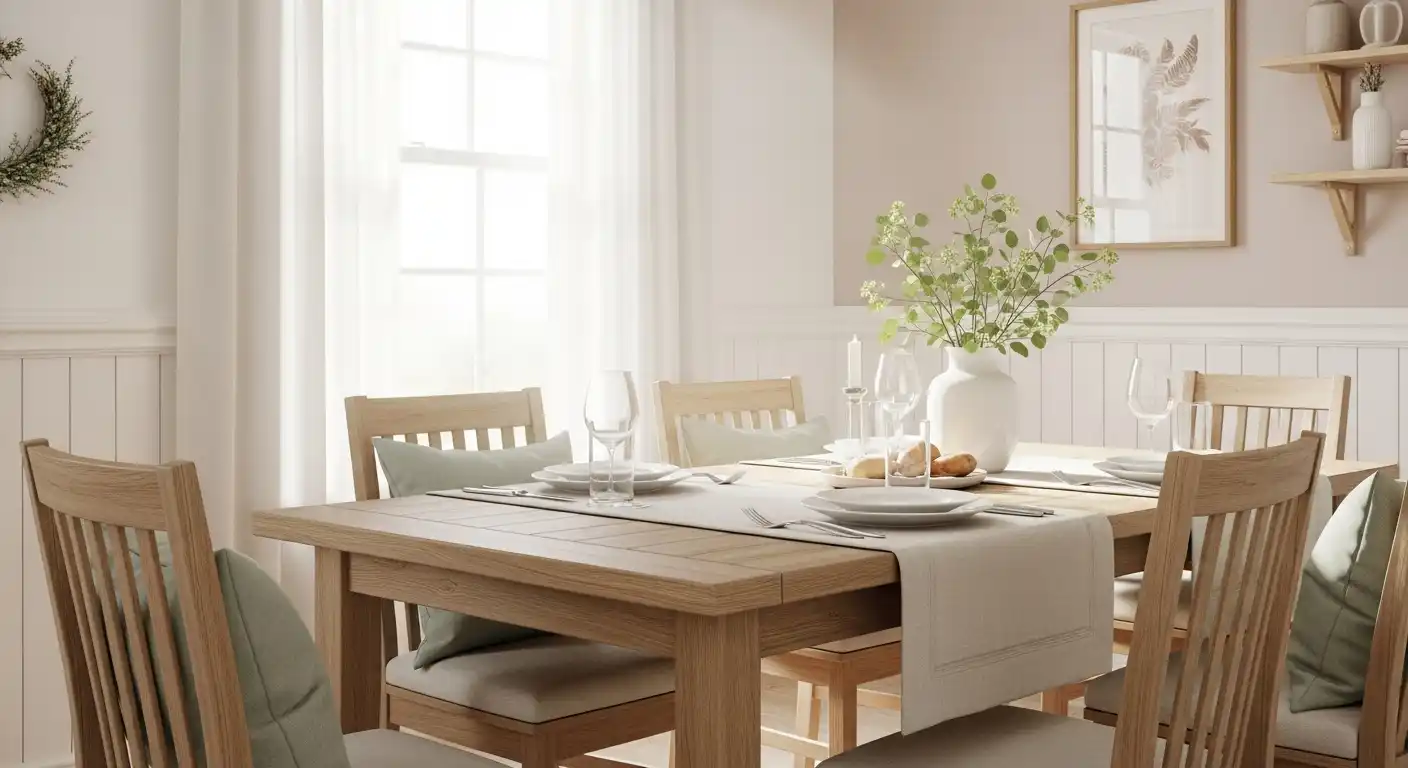
The right palette can evoke warmth, charm, and timeless simplicity—qualities that define farmhouse style.
But with so many color options, how do you choose the perfect hues that complement rustic wood, vintage accents, and cozy textiles?
In this post, we’ll explore the best colors for a farmhouse dining room, how to blend neutrals with accent shades, and tips for creating a balanced, inviting space that feels both classic and fresh.
Christmas & Year-End Deals On Amazon !
Don’t miss out on the best discounts and top-rated products available right now!
*As an Amazon Associate, I earn from qualifying purchases.
Whether you’re refreshing your current dining area or starting from scratch, this guide will help you pick colors that bring out the best in farmhouse design.
Why Color Matters in a Farmhouse Dining Room
Farmhouse style is beloved for its warm, welcoming vibe and effortless charm. Colors are the foundation of this feeling.

A farmhouse dining room should feel inviting and comfortable—a place where family and friends want to gather for meals and meaningful conversations.
The colors you choose influence not only the look but also the mood of the room.
Soft, natural hues create a calm backdrop that highlights rustic wood tables and vintage lighting.
Meanwhile, carefully chosen accent colors add depth and personality without overpowering the simplicity that farmhouse design celebrates.
The Classic Neutral Palette: Whites, Creams, and Soft Grays
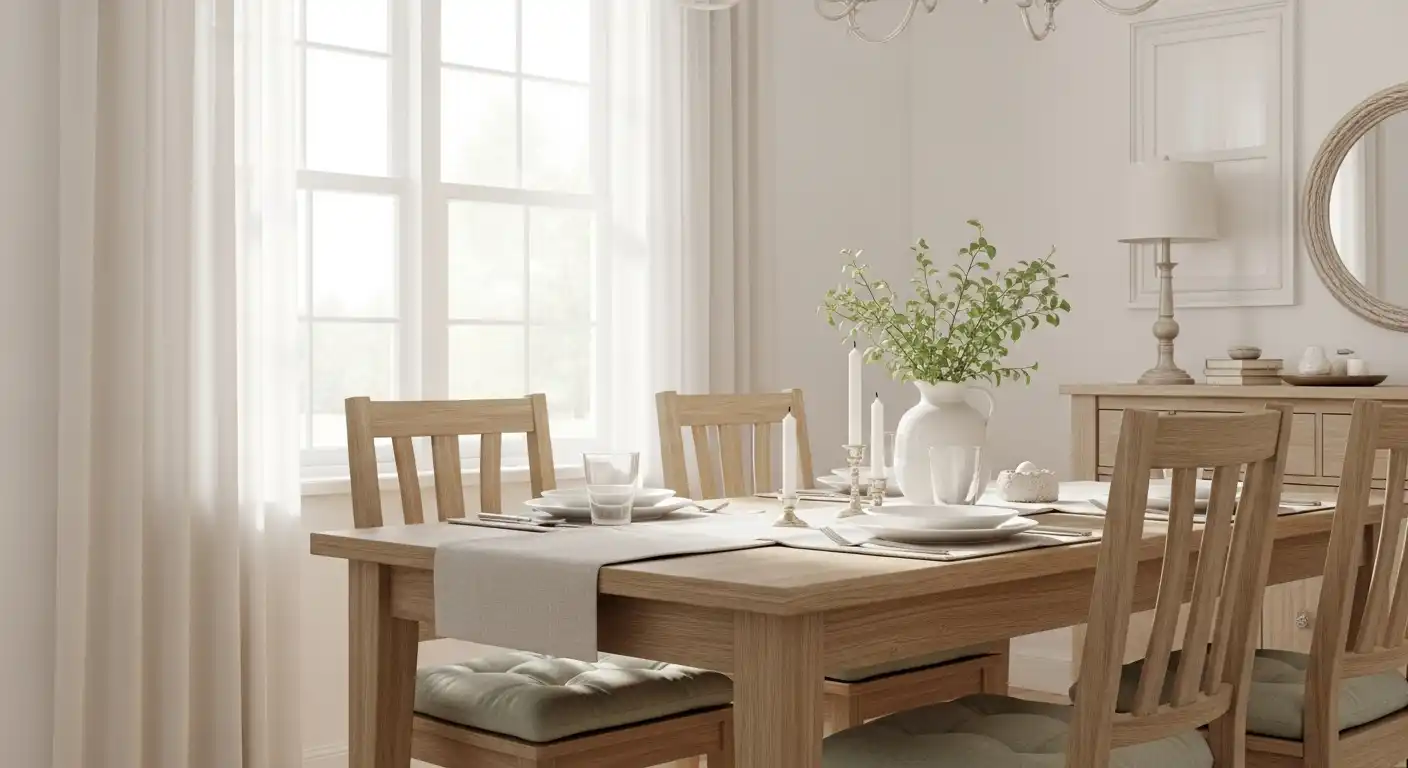
The heart of farmhouse color schemes lies in neutral tones. Whites, creams, and soft grays are the go-to choices because they:
- Reflect natural light beautifully, making the space feel bright and airy.
- Provide a clean, timeless backdrop that pairs seamlessly with wood textures.
- Create a sense of calm and simplicity, essential to farmhouse style’s relaxed feel.
For walls, a soft white or creamy off-white is ideal. These shades keep the room feeling fresh and open, allowing your furniture and decor to shine.
Soft grays work wonderfully as a secondary wall color or on trim and cabinetry.
They add subtle contrast while maintaining the understated elegance farmhouse rooms demand.
If you want to see how these neutrals play out in real farmhouse dining rooms, check out some inspiring farmhouse dining room ideas that showcase this palette beautifully.
Bringing in Earthy Tones for Warmth and Depth

While neutrals form the base, incorporating earthy tones helps ground the space and adds warmth. Think about shades inspired by nature:
- Warm taupes and beiges
- Muted sage greens
- Soft clay or terracotta hues
- Dusty blues and navy accents
These colors complement the natural wood finishes common in farmhouse dining rooms, such as reclaimed wood tables or distressed cabinets.
For example, a sage green accent wall or a set of dining chair cushions in muted blue can create a cozy, layered look without overwhelming the room.
Christmas & Year-End Deals On Amazon !
Don’t miss out on the best discounts and top-rated products available right now!
*As an Amazon Associate, I earn from qualifying purchases.
If you’re curious about combining earthy tones with farmhouse style, the earthy neutrals farmhouse kitchen color scheme offers plenty of ideas to inspire your dining space.
Using Contrast: Darker Shades for Accents
To avoid a washed-out or overly pale look, adding contrast with deeper colors is key.
Deep navy, forest green, charcoal gray, or even black accents can bring sophistication and visual interest.
Consider these options:
- Painting a single wall in a rich, dark color to create a focal point.
- Choosing dark metal finishes for lighting fixtures or hardware.
- Incorporating dark wood tones or painted furniture pieces.
These touches balance the light neutrals and help define the farmhouse dining room’s character.
For a fresh take on blending rustic charm with modern accents, explore transitional dining room ideas that often mix these contrasts beautifully.
How to Use Color on Different Surfaces in Your Farmhouse Dining Room
Walls
Walls offer the largest canvas and set the overall tone.
- Use soft whites or creams for most walls to keep the space open.
- Add shiplap paneling painted in white or light gray for texture and interest.
- Consider an accent wall in a muted green or blue for subtle color.
Shiplap is a classic farmhouse element that adds warmth without heaviness, and it pairs well with neutral paint. You can see more on this in farmhouse dining room ideas.
Furniture
Farmhouse dining rooms often feature reclaimed or distressed wood tables and chairs.
- Keep wood tones natural or lightly stained to showcase grain.
- Painted furniture in creamy whites or soft grays works well to brighten the room.
- Mix wood and metal chairs in black or bronze finishes to add contrast.
Textiles
Textiles bring softness and color layering.
- Use neutral slipcovers in linen or cotton for dining chairs.
- Add cushions, table runners, or curtains in plaid, stripes, or subtle florals with earthy tones.
- Layer natural fiber rugs like jute or sisal under the table to add texture and warmth.
For more on textiles and layering, check out best dining rugs for different styles.
Lighting
Lighting fixtures can also introduce color and style.
Christmas & Year-End Deals On Amazon !
Don’t miss out on the best discounts and top-rated products available right now!
*As an Amazon Associate, I earn from qualifying purchases.
- Vintage-inspired pendant lights in brass or black metal add warmth and character.
- Lampshades in natural fibers or soft hues keep the look cohesive.
Explore more ideas in dining room lighting inspiration.
Tips for Choosing Colors in a Small Farmhouse Dining Room
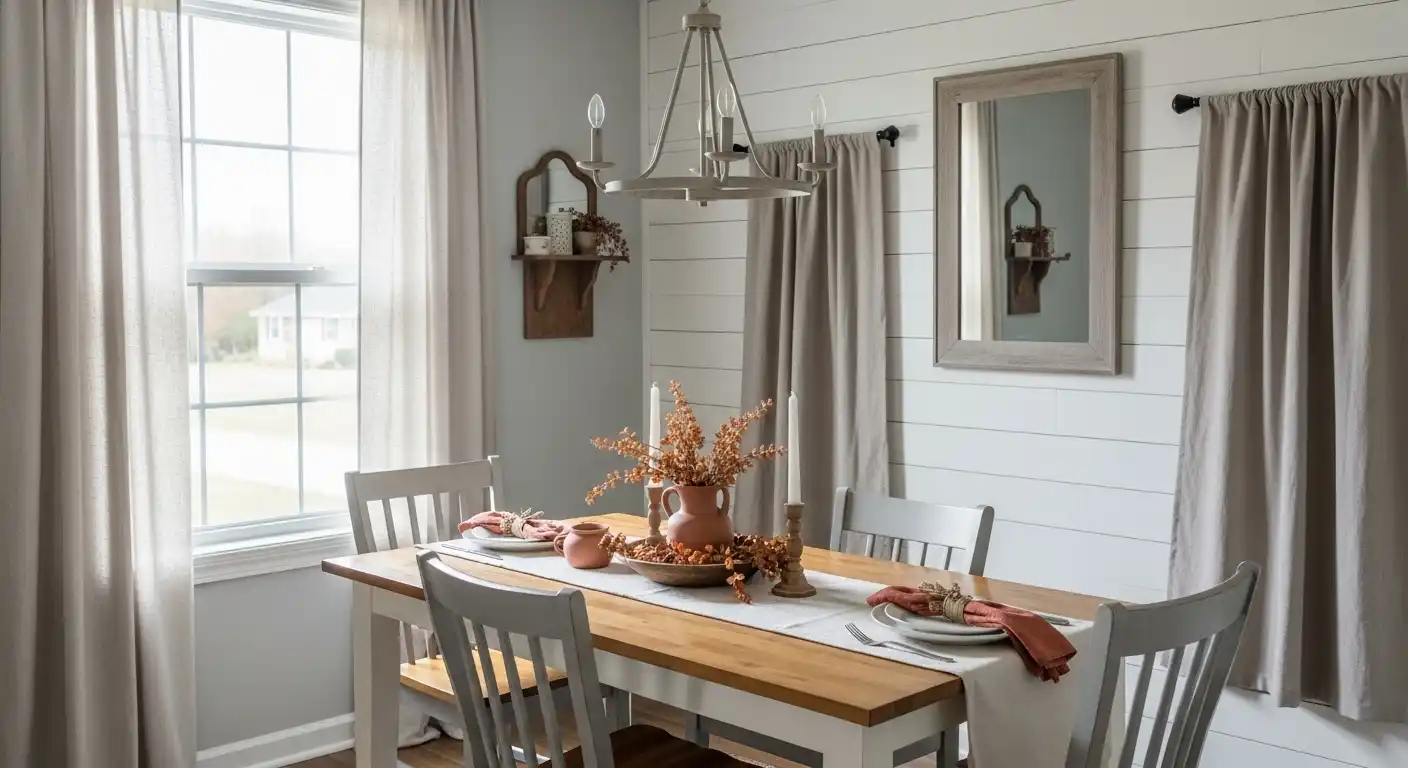
If your farmhouse dining room is on the smaller side, color choices become even more important in creating a sense of space.
Light, neutral colors on walls and ceilings help reflect light and make the room feel larger.
Avoid heavy, dark colors on all walls as they can make the space feel cramped.
Instead, use darker tones sparingly for accents like a single wall, artwork, or furniture.
Mirrors can amplify light and space—consider adding a large mirror with a distressed wood frame to complement your color scheme.
For more detailed strategies, see our guide on how to make a small dining room look bigger.
How to Combine Colors with Farmhouse Decor Elements
The farmhouse dining room isn’t just about paint. It’s the sum of many parts working together.
Here’s how to harmonize colors with decor:
- Wood: Reclaimed or natural wood adds warmth and authenticity. The grain and texture stand out best against neutral walls.
- Metal: Black, bronze, or galvanized metal finishes add an industrial edge and contrast nicely with soft colors.
- Textiles: Linen, burlap, and cotton in soft shades soften the space and add comfort.
- Vintage Accents: Use distressed finishes and vintage-inspired pieces to bring character without clutter.
- Greenery: Fresh flowers or potted plants in simple vases add a pop of natural color and life.
You can find inspiration on combining these elements in farmhouse style dining room setup.
Seasonal and Personal Touches to Refresh Your Color Scheme
One of the joys of farmhouse design is its adaptability. You can easily refresh your dining room’s look by changing accents with the seasons.
- Swap out floral centerpieces for pumpkins and gourds in fall.
- Use pastel linens and fresh greenery in spring.
- Add cozy throws and warm-toned candles in winter.
Simple changes keep the space feeling fresh and connected to nature’s rhythms.
Christmas & Year-End Deals On Amazon !
Don’t miss out on the best discounts and top-rated products available right now!
*As an Amazon Associate, I earn from qualifying purchases.
For ideas on seasonal updates, explore seasonal dining table decor.
Final Thoughts: Creating the Perfect Color Palette for Your Farmhouse Dining Room
Choosing colors for your farmhouse dining room is about balance—between light and dark, warm and cool, rustic and refined.
Start with a neutral base of whites, creams, or soft grays to keep the room bright and timeless.
Layer in earthy tones and deeper accents to add warmth and personality.
Don’t forget to consider how your furniture, textiles, and lighting will interact with your chosen palette.
If you want more ideas on furnishing and styling your space, check out our guides on how to furnish a small dining room and farmhouse dining room ideas.
With thoughtful color choices, your farmhouse dining room will be a welcoming, cozy space where memories are made—full of character, charm, and timeless beauty.
Explore More:
- For tips on layering textures and lighting, see dining room lighting inspiration.
- To add personality with art and decor, visit dining room display ideas.
- Want to keep your small dining area functional and stylish? Check out small dining space design tips.



